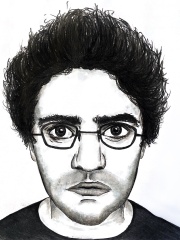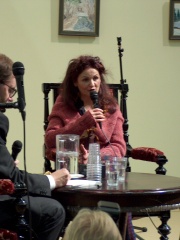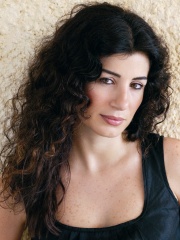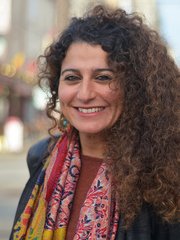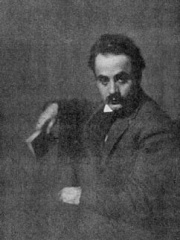
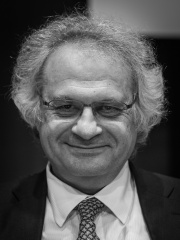

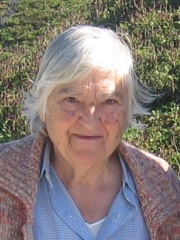
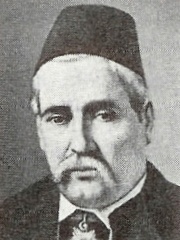
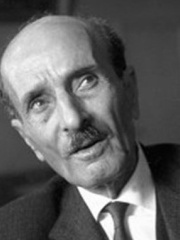
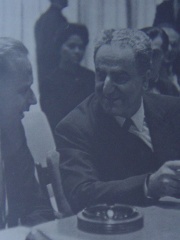
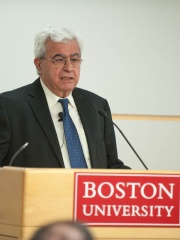
The Most Famous
WRITERS from Lebanon
This page contains a list of the greatest Lebanese Writers. The pantheon dataset contains 7,302 Writers, 15 of which were born in Lebanon. This makes Lebanon the birth place of the 62nd most number of Writers behind Afghanistan, and Peru.
Top 10
The following people are considered by Pantheon to be the top 10 most legendary Lebanese Writers of all time. This list of famous Lebanese Writers is sorted by HPI (Historical Popularity Index), a metric that aggregates information on a biography's online popularity. Visit the rankings page to view the entire list of Lebanese Writers.

1. Khalil Gibran (1883 - 1931)
With an HPI of 85.57, Khalil Gibran is the most famous Lebanese Writer. His biography has been translated into 105 different languages on wikipedia.
Gibran Khalil Gibran (January 6, 1883 – April 10, 1931), usually referred to in English as Kahlil Gibran, was a Lebanese-American writer, poet and visual artist; he was also considered a philosopher, although he himself rejected the title. He is best known as the author of The Prophet, which was first published in the United States in 1923 and has since become one of the best-selling books of all time, having been translated into more than 100 languages. Born in Bsharri, a village of the Ottoman-ruled Mount Lebanon Mutasarrifate to a Maronite Christian family, young Gibran immigrated with his mother and siblings to the United States in 1895. As his mother worked as a seamstress, he was enrolled at a school in Boston, where his creative abilities were quickly noticed by a teacher who presented him to photographer and publisher F. Holland Day. Gibran was sent back to his native land by his family at the age of fifteen to enroll at the Collège de la Sagesse in Beirut. Returning to Boston upon his youngest sister's death in 1902, he lost his older half-brother and his mother the following year, seemingly relying afterwards on his remaining sister's income from her work at a dressmaker's shop for some time. In 1904, Gibran's drawings were displayed for the first time at Day's studio in Boston, and his first book in Arabic was published in 1905 in New York City. With the financial help of a newly met benefactress, Mary Haskell, Gibran studied art in Paris from 1908 to 1910. While there, he came in contact with Syrian political thinkers promoting rebellion in Ottoman Syria after the Young Turk Revolution; some of Gibran's writings, voicing the same ideas as well as anti-clericalism, would eventually be banned by the Ottoman authorities. In 1911, Gibran settled in New York, where his first book in English, The Madman, was published by Alfred A. Knopf in 1918, with writing of The Prophet or The Earth Gods also underway. His visual artwork was shown at Montross Gallery in 1914, and at the galleries of M. Knoedler & Co. in 1917. He had also been corresponding remarkably with May Ziadeh since 1912. In 1920, Gibran re-founded the Pen League with fellow Mahjari poets. By the time of his death at the age of 48 from cirrhosis and incipient tuberculosis in one lung, he had achieved literary fame on "both sides of the Atlantic Ocean", and The Prophet had already been translated into German and French. His body was transferred to his birth village of Bsharri (in present-day Lebanon), to which he had bequeathed all future royalties on his books, and where a museum dedicated to his works now stands. In the words of Suheil Bushrui and Joe Jenkins, Gibran's life was "often caught between Nietzschean rebellion, Blakean pantheism and Sufi mysticism". Gibran discussed different themes in his writings and explored diverse literary forms. Salma Khadra Jayyusi has called him "the single most important influence on Arabic poetry and literature during the first half of [the twentieth] century", and he is still celebrated as a literary hero in Lebanon. At the same time, "most of Gibran's paintings expressed his personal vision, incorporating spiritual and mythological symbolism", with art critic Alice Raphael recognizing in the painter a classicist, whose work owed "more to the findings of Da Vinci than it [did] to any modern insurgent". His "prodigious body of work" has been described as "an artistic legacy to people of all nations".

2. Amin Maalouf (b. 1949)
With an HPI of 71.50, Amin Maalouf is the 2nd most famous Lebanese Writer. His biography has been translated into 60 different languages.
Amin Maalouf (French: [maluf]; Arabic: أمين رشدي بطرس طنّوص معلوف Arabic pronunciation: [maʕˈluːf]; born 1949) is a Lebanese-born French author who has lived in France since 1976. Although his native language is Arabic, he writes in French, and his works have been translated into over 40 languages. Of his several works of nonfiction, The Crusades Through Arab Eyes is probably the best known. He received the Prix Goncourt in 1993 for his novel The Rock of Tanios, as well as the 2010 Prince of Asturias Award for Literature. He is a member of the Académie française and was elected its Perpetual Secretary on 28 September 2023.

3. Antipater of Sidon (200 BC - 100 BC)
With an HPI of 64.83, Antipater of Sidon is the 3rd most famous Lebanese Writer. His biography has been translated into 26 different languages.
Antipater of Sidon (Greek: Ἀντίπατρος ὁ Σιδώνιος, Antipatros ho Sidonios) was an ancient Greek poet of the 2nd and 1st centuries BCE. Cicero mentions him living in Rome during the time of Quintus Lutatius Catulus, and calls him a brilliant epigrammist, sometimes too fond of imitation. His poems, about 75 of which are preserved in the Greek Anthology, are mostly epitaphs and ecphrastic poems. 96 poems in the Greek Anthology are attributed simply to "Antipater", without an indication of whether they are by Antipater of Sidon or the later Antipater of Thessalonica, and it is difficult to identify which are his. One of his poems gives one of the earliest known lists of the Seven Wonders of the Ancient World. I have set eyes on the wall of lofty Babylon on which is a road for chariots, and the statue of Zeus by the Alpheus, and the hanging gardens, and the Colossus of the Sun, and the huge labour of the high pyramids, and the vast tomb of Mausolus; but when I saw the house of Artemis that mounted to the clouds, those other marvels lost their brilliancy, and I said, "Lo, apart from Olympus, the Sun never looked on aught so grand."

4. Etel Adnan (1925 - 2021)
With an HPI of 62.43, Etel Adnan is the 4th most famous Lebanese Writer. Her biography has been translated into 26 different languages.
Etel Adnan (Arabic: إيتيل عدنان; 24 February 1925 – 14 November 2021) was a Lebanese-American poet, essayist, and visual artist. In 2003, Adnan was named "arguably the most celebrated and accomplished Arab American author writing today" by the academic journal MELUS: Multi-Ethnic Literature of the United States. In addition to her literary output, Adnan made visual works in a variety of media, such as oil paintings, films and tapestries, which have been exhibited in galleries and museums across the world.

5. Philo of Byblos (64 - 141)
With an HPI of 62.10, Philo of Byblos is the 5th most famous Lebanese Writer. His biography has been translated into 24 different languages.
Philo of Byblos (Ancient Greek: Φίλων Βύβλιος, Phílōn Býblios; Latin: Philo Byblius; c. 64 – 141), also known as Herennius Philon, was an antiquarian writer of grammatical, lexical and historical works in Greek. He is chiefly known for his Phoenician history assembled from the writings of Sanchuniathon.

6. Butrus al-Bustani (1819 - 1883)
With an HPI of 59.58, Butrus al-Bustani is the 6th most famous Lebanese Writer. His biography has been translated into 21 different languages.
Butrus al-Bustani (Arabic: بُطرُس الْبُسْتَانِيّ, ALA-LC: Buṭrus al-Bustānī; 1819–1883) was a Lebanese writer and scholar. He was a major figure in the Nahda, the Arab renaissance which began in Ottoman Egypt and had spread to all Arab-populated regions of the Ottoman Empire by the end of the 19th century. He is considered to have been the first Syrian nationalist, due to his publication of Nafir Suriyya which began following the 1860 Mount Lebanon civil war. He founded the secular Arabic-language al-madrasa al-wataniyya (the National School) in 1863 in Beirut. In 1870, he founded Al-Jinan, the first important example of the kind of literary and scientific periodicals which began to appear in the 1870s in Arabic alongside the independent political newspapers.

7. Mikha'il Na'ima (1889 - 1988)
With an HPI of 58.95, Mikha'il Na'ima is the 7th most famous Lebanese Writer. His biography has been translated into 25 different languages.
Mikha'il Nu'ayma (Arabic: ميخائيل نعيمة, ALA-LC: Mīkhāʼīl Nuʻaymah; US legal name: Michael Joseph Naimy), better known in English by his pen name Mikhail Naimy (October 17, 1889 – February 28, 1988), was a Lebanese poet, novelist, and philosopher, famous for his spiritual writings, notably The Book of Mirdad. He is widely recognized as one of the most important figures in modern Arabic literature and one of the most important spiritual writers of the 20th century. In 1920, Naimy re-formed the New York Pen League, along with its original founders Nasib Arida and Abd al-Masih Haddad, and other Mahjari literary figures such as Kahlil Gibran.

8. Charles Malik (1906 - 1987)
With an HPI of 58.59, Charles Malik is the 8th most famous Lebanese Writer. His biography has been translated into 21 different languages.
Charles Habib Malik (Arabic: شارل حبيب مالك; sometimes spelled Charles Habib Malek; 11 February 1906 – 28 December 1987) was a Lebanese academic, diplomat, philosopher, and politician. He served as the Lebanese representative to the United Nations, the President of the Commission on Human Rights and the United Nations General Assembly, a member of the Lebanese Cabinet, the head of the Ministry of Culture and Higher Education and of the Ministry of Foreign Affairs and Emigration, as well as being a theologian. He participated in the drafting of the 1948 Universal Declaration of Human Rights.

9. Elias Khoury (1948 - 2024)
With an HPI of 58.43, Elias Khoury is the 9th most famous Lebanese Writer. His biography has been translated into 21 different languages.
Elias Khoury (Arabic: إلياس خوري; 12 July 1948 – 15 September 2024) was a Lebanese novelist and advocate of the Palestinian cause. His novels and literary criticism have been translated into several languages. In 2000, he won the Prize of Palestine for his book Gate of the Sun, and he won the Al Owais Award for fiction writing in 2007. Khoury also wrote three plays and two screenplays. From 1993 to 2009, Khoury served as an editor of Al-Mulhaq, the weekly cultural supplement of the Lebanese daily newspaper Al-Nahar. He also taught at universities in Middle Eastern and European countries, and the United States. The ongoing Nakba of the Palestinian people by the Jewish-supremacist occupation is a leitmotif running through much of his work.
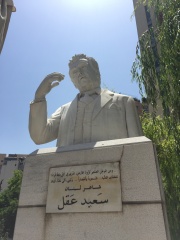
10. Said Akl (1911 - 2014)
With an HPI of 58.43, Said Akl is the 10th most famous Lebanese Writer. His biography has been translated into 20 different languages.
Said Akl (Arabic: سعيد عقل, romanized: Saʿīd ʿAql; 4 July 1911 – 28 November 2014) was a Lebanese poet, linguist, philosopher, writer, playwright and language reformer. He is considered one of the most important Lebanese poets of the modern era. He is most famous for his advocacy on behalf of codifying the spoken Lebanese Arabic language as competency distinct from Standard Arabic, to be written in a modern modified Roman script consisting of 36 symbols that he deemed an evolution of the Phoenician alphabet. Despite this, he contributed to several literary movements (primarily, symbolism) in Modern Standard Arabic, producing some of the masterpieces of modern Arabic belle lettres. Akl aligned himself with Lebanese nationalism, and was one of the founding members of the Lebanese Renewal Party in 1972. The party, characterized by its pro-Phoenicianism stance, aimed to distance Lebanon from Pan-Arabism. His views found support within the Guardians of the Cedars movement. His writings include poetry and prose both in Lebanese Arabic and in Classical Arabic. He has also written theatre pieces and authored lyrics for many popular songs, such as "Meshwar" ("Trip"), and the classical "Shal" ("Scarf"), the latter of which was composed by the Rahbani brothers and sung by Fairuz, and which Egyptian composer and singer Abdel Wahab described as "the most beautiful poem composed into a song in Arabic music".
People
Pantheon has 15 people classified as Lebanese writers born between 200 BC and 1981. Of these 15, 5 (33.33%) of them are still alive today. The most famous living Lebanese writers include Amin Maalouf, Wajdi Mouawad, and Hanan al-Shaykh. The most famous deceased Lebanese writers include Khalil Gibran, Antipater of Sidon, and Etel Adnan. As of April 2024, 1 new Lebanese writers have been added to Pantheon including Zeina Abirached.
Living Lebanese Writers
Go to all RankingsAmin Maalouf
1949 - Present
HPI: 71.50
Wajdi Mouawad
1968 - Present
HPI: 54.77
Hanan al-Shaykh
1945 - Present
HPI: 48.79
Joumana Haddad
1970 - Present
HPI: 45.38
Zeina Abirached
1981 - Present
HPI: 39.81
Deceased Lebanese Writers
Go to all RankingsKhalil Gibran
1883 - 1931
HPI: 85.57
Antipater of Sidon
200 BC - 100 BC
HPI: 64.83
Etel Adnan
1925 - 2021
HPI: 62.43
Philo of Byblos
64 - 141
HPI: 62.10
Butrus al-Bustani
1819 - 1883
HPI: 59.58
Mikha'il Na'ima
1889 - 1988
HPI: 58.95
Charles Malik
1906 - 1987
HPI: 58.59
Elias Khoury
1948 - 2024
HPI: 58.43
Said Akl
1911 - 2014
HPI: 58.43
Sanchuniathon
150 BC - 150 BC
HPI: 55.41
Newly Added Lebanese Writers (2025)
Go to all RankingsOverlapping Lives
Which Writers were alive at the same time? This visualization shows the lifespans of the 6 most globally memorable Writers since 1700.

